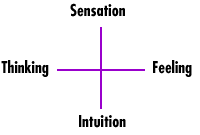Positive Health Online
Your Country

More on Jung
by Sheldon Litt, Ph.D.(more info)
listed in psychology, originally published in issue 59 - December 2000
My last article dealt with Carl Jung, the famous analyst who developed a system that became one of the main rivals to Freud.
Certainly it's impossible to do justice to the complexities of Jung's thought in a short article, so in continuing our look at the popular Swiss school of analytic psychology, the focus will be on aspects which have found their way into psychology.
As mentioned in the previous column, Jung's notions of creativity have had the most acceptance by psychologists of various disciplines.
In a general sense, Jungians stress that the psychic energy, the 'libido' is not just sexual as it is claimed by orthodox followers of Freud. And dream interpretation in the Jungian style also departs from the Vienna school is a decisive manner. Jung criticized Freud for missing the creative futurity of the dream. Jung also considered the dream to fulfil a compensation function. That is, the dream reveals those dimensions of our psyche that we have failed to develop in our waking life. This notion was further developed by the dreamwork of Fritz Perls, which sees the dream as filling in the holes of the personality.
Jung himself used his dreams for inspiration, and not infrequently he was influenced by a dream to change the direction of his life. He relied on dreams perhaps more often than any other psychotherapist; the interpretation of dreams often plays a major role in the work of the Jungian school of psychoanalysis, or analytic psychology as he termed his method.
In fact, Jung was not averse to using symbols and ideas from alchemy in his approach to dream interpretation. One observer called Jung's method a tour de force of symbolical analysis. In one of his cases, which he describes in a book, Jung collected more than 1,000 dreams and visions from a young male patient! He then tried to relate these fantasies to ancient philosophical and religious systems.
One of the more useful aspects of Jung's work is his concept of active imagination, which has been adapted for use by other schools of psychotherapy. Here the conscious creative ability of the patient is harnessed in the attempt to discover new horizons. The method is quite simple, but often leads to increased understanding of the self. Instead of simply remembering a dream and reciting it back to the therapist, here the person is asked to concentrate his attention on one image of the dream. Instead of a dream, one can also focus on some spontaneous visual image. The task is to then just observe what happens to this image. For example, close your eyes and focus on what you see with your eyes closed. Don't attempt to change the image, or force it into any preconceived idea; just let it develop by itself.
Here the critical faculties are suspended, and the assignment is simply to attend to what is happening, observing closely the here and now situation. Gradually, one may notice small changes in the image presented; these may be followed up, or even presented in an artwork (paint or draw your fantasy!), which may lead to, in Jungian terminology, unconscious material to be worked on further.
This method can be highly effective in the treatment of artists suffering from creative block. I have had several artists in my practice who were experiencing a period of creative decline. They seem to have run out of ideas and energy. Instead of seeking new horizons by travelling to faraway lands, I suggested this method, which consists of an inner trip. No LSD or other drugs are required! It is simply concentrating on one's own sensations and images, and continuing the process by mental focusing or moving on to reproducing the fantasy in a work of art, however primitive.
Imagination can be used much in the same way as dreams – paying attention to the different aspects, painting the image and then moving on to understand and/or expand it constructively.
In addition to using this approach with artists and other creative people with special problems, it can also be applied to anyone who is interested in expanding his creative capacity.
Another contribution of Jung was his typology, which some clinicians adapt for understanding human differences. Jung identifies two fundamental attitudes towards experiencing the introverted attitude and the extroverted. The introvert is a person who experiences life inwardly – towards the inner world of the psyche; while the extrovert is more a type who is inclined to get his answers from other people, i.e. he experiences life outside of himself.

Figure 1
But this well-known dichotomy is only the first state of Jung's complicated system of types: there is also the dimension of 'perceptual functioning' versus 'evaluative functioning' to consider (see Figure 1). On one axis are the two perceptual functions – sensation and intuition.
On the other axis we find the evaluative functions – thinking and feeling. And in order to describe people, all of these dimensions must be considered. Thus one person may emphasize the logical, rational aspects of life, while another lives more through his gut feelings.
One reason, perhaps, for the endurance of the Jungian school is the complexity of his conceptions.
Comments:
-
No Article Comments available